Rena
Rena
The Rena became the largest shipwreck in New Zealand waters at 2:20 am on 5 October 2011. The Rena weighed in at 37,209 tonnes and was originally named Zim America when she was launched in 1990. It was the Captain’s birthday
The Rena was a Liberian registered container ship chartered by The Mediterranean Shipping Company and was sailing from Napier to Tauranga to drop off and collect cargo. With three crew members on duty in slightly overcast conditions and travelling at full speed of seventeen knots the Rena ran aground on the Astrolabe Reef which is clearly marked on shipping charts. Astrolabe Reef is located offshore from Papamoa Beach, a popular holiday spot for locals and tourists.
The wreck of the Rena was visible from the shoreline as she lay stranded on the reef listing to starboard. It was soon established by salvage experts from the Netherlands that the Rena could not be refloated as damage was too extensive and an operation was mounted to remove containers which remained on the ship and recover containers that had broken free. Many of these containers ended up on the beaches south of Tauranga along with bunker oil which had escaped from the ships fuel tanks.

A major cleanup operation was mounted including local volunteers to deal with the oil slick which arrived on the Tauranga beaches and as far south as Whakatane sixty kilometres away. The mess on the beaches had a severe impact on local businesses which relied on summer holiday trade. On 12 January 2012 the Rena broke in half after being pounded by ocean swells which weakened the wreck. By this time the remaining bunker fuel had been transferred from The Rena’s fuel tanks onto barges.
The wreck of the Rena was the largest shipwreck in New Zealand since the Mikhael Lermontov sank after hitting a reef off Point Jackson at the top of the South Island. The cleanup and salvage operation for the Rena cost $700M NZD to remove the ship to below her waterline. The owners applied for resource consent to leave the remainder of the ship in place as an artificial reef. Resource consent was granted against the wishes of the local Iwi.
An enquiry was carried out into the cause of the sinking. The Rena had travelled the same route several times previously and was scheduled to meet a pilot boat at 3:00 am to be in time to enter Tauranga on a high tide. The Captain had authorised the second mate to make course adjustments to avoid obstacles and it was clear that the 3:00 am pilot boat deadline was driving the crew to literally cut corners.
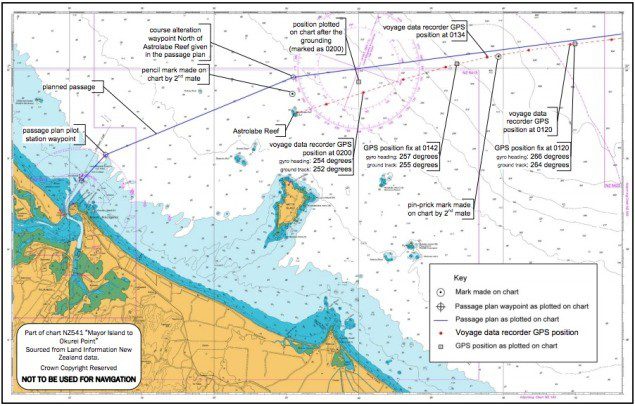
The captain of the Torea, a coastal tanker, had to take an evasive maneuver to create separation from the Rena as she overtook his ship between Napier and Tauranga. The captain of the Rena came onto the bridge to take control of the ship for the entry into Port Tauranga. However when he arrived on the bridge the crew did not update him on the position of the ship after the course adjustments made by the second mate. While the handover to the captain was happening there was no one monitoring the position of the ship and at 2:14 am she ran onto Astrolabe Reef. The enquiry determined that there were no failures of navigation systems or ship’s equipment and that the grounding was a result of human error.
The captain and the second mate were found guilty of eleven charges including operating a vessel in a reckless manner, environmental discharges and altering ships documents after an accident. They were both sentenced to seven months in jail.
Fortunately there were no lives lost in the incident but the environmental damage and loss of sealife and birdlife was greater than any previous shipwreck in New Zealand Waters.
Andrea Doria
The Andrea Doria was launched in 1951 and carried out her maiden voyage on 14 Jan 1953. Named after a 16th century Genoese Admiral, the Andrea Doria represented the pride of the Italian commercial fleet as a fast luxury liner 213 metres long weighing 29,000 tons. She could carry 1241 passengers and crew at 23 knots powered by steam turbines and twin propellors. Although not the fastest or largest luxury liner by any means she was an important symbol of the re-building of Italy in the post-war era and was lauded as a safe ship.
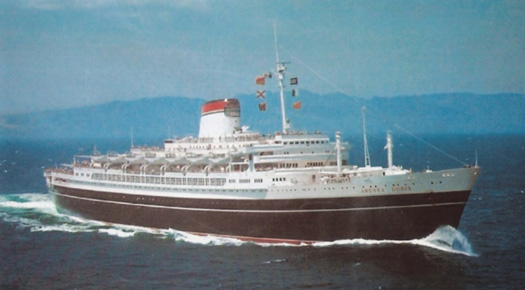
On 17 July 1956 the Andrea Doria left her home port of Genoa with 277 passengers and crew on board and then headed to Cannes to embark a further 48. Leaving Cannes she travelled to Naples to load a further 744 passengers before sailing across the Mediterranean to embark the final 65 passengers at Gibraltor before setting sail across the Atlantic heading for New York.
The Atlantic crossing was uneventful however upon approaching Nantucket light off New York, fog descended at night and visibility became limited. The Andrea Doria closed her watertight compartments and sounded her foghorn to warn other ships of her presence. She was travelling south of Nantucket light to avoid the shoals south of Nantucket Island.
In the 1950’s there were no sea traffic corridors to create separation between vessels travelling in opposite directions and collision avoidance was based on radar and watchkeeper lookout.
On the same evening, while the Andrea Doria approached New York, the passenger vessel Stockholm owned by the Swedish American Line had departed New York. The Stockholm was smaller than the Andrea Doria at 160 m length. Originally she carried 395 passengers and crew across two classes but was extended to increase her carrying capacity. She left New York with 534 passengers and 208 crew.
As she was heading east the Stockholm was not yet in fog. The two ships could see each other on radar but the technology of the time required manual plotting of radar traces. There was no radio contact between the two ships and it became clear that the two ships needed to adjust course to pass by each other. The Andrea Doria veered to port and the Stockholm veered to starboard. It was a fateful set of decisions as the two ships remained on a collision course. Both ships finally saw each other in thick fog and again adjusted course by repeating the earlier manoeuvre, therefore again veering onto what quickly became an unavoidable collision course.

Late in evening of 25 July 1956 the Stockholm struck the Andrea Doria amidships and her bow plunged deep into the Andrea Doria hull penetrating almost half way through. At the end of a long voyage the Andrea Doria’s fuel tanks were nearly empty and the tanks on her starboard side were ruptured taking on water. Engineers attempted to flood the port fuel tanks to stabilise the ship however the water intakes on the port side had already risen clear of the water line as a result of the rapid list developing as the Andrea Doria took on water.
Meanwhile the Stockholm floated free and sat bow down as she took on water in her bow section. The Stockholm’s engineers managed to pump out fresh water tanks in the bow section and bring the ship almost level and stabilised.
The Andrea Doria was able to lower empty lifeboats on her port side only due to the severe list and passengers had to then climb down Jacobs ladders to climb into the lifeboats. Her port side lifeboats could not be lowered.

Unlike the Titanic there were a number of other vessels nearby that could render assistance. The 120m freighter Cape Anne was first to arrive followed by United States Navy transport ship the Private William H Thomas along with the Destroyer Edward H Allen and Coastguard cutter US Ligere. Forty four miles to the east the French liner Isle de France, a 225 metre 45,000 tons liner travelling from New York to Le Havre turned back to assist. By the time Isle de France arrived the Stockholm had sent its own lifeboats to ferry passengers from the Andrea Doria to other vessels. Once the Isle de France arrived on the scene she turned on all her floodlights as it was well after midnight. Ten Isle de France lifeboats were launched and passengers were transferred to her. Over 1660 people were rescued from the Stockholm and Andrea Doria however 46 were dead on the Andrea Doria as a direct result of the collision.
The Andrea Doria sank 11 hours after the collision on the morning of 26 July 1956.
The exact cause of the sinking was never established as the two shipping companies settled out of court. It seems likely that inadequate operation of radars was the cause.
The Andrea Doria was not salvaged and remains on the sea floor south of Nantucket Island.

MS Estonia
The MS Estonia was a cruise ferry which sank in the Baltic Sea in 1994 resulting in the deaths of 852 people and becoming the second worst maritime disaster since the RMS Titanic.
It was launched on the 18th of October 1980 and began its life as the MS Viking Sally before being called the Silja Star, Wasa King and finally the MS Estonia. The MS Estonia was 155 meters long and weighed 15,598 tones. It was a cross between a cruise ship and a ferry and was capable of holding around 2000 passengers and around 400 cars.
The ships bow could be opened to allow cars to drive onto the boat and when closed formed part of the outer hull. When in the open position the visor would hinge up and a ramp would be deployed out from the ship onto the port acting as a bridge for cars to drive over onto the vehicle deck.
On the 27th of September 1994 the MS Estonia started off the day by boarding vehicles and freight in the port of Tallinn Estonia. By 7:00pm all of the vehicles and passengers had boarded the Ship and it set sail to Stockholm Sweden across the Baltic Sea.
The Estonia left the port with a slight list onto its starboard side (right side) as the weight distribution of the vehicles on board was uneven. As the Estonia crossed the Baltic Sea the weather became worse and by midnight it entered into a storm. The high wind and rain resulted in three to four meter high waves.
The slight list on the ships starboard side increased as the wind was blowing against the port side (left side). The ship used water balancing tanks to increase stability and counteract the starboard listing. The water balancing tanks work by pumping and draining water into tanks on each side of the ship to create more or less weight.
The ship adjusted its course at around 12:00pm but this meant that the wind was now hitting the port bow side. The ship began pitching up and down and rolling from side to side a lot more. To counteract this the fin stabilizers were deployed to improve stability and stop the ship from rolling from side to side. The pitching motion of the bow of the ship rising up and slamming down on the waves continued to go on. This pitching meant that the visor of the ship which acted as the door for vehicles was taking the full impact of every wave as it ploughed through the storm.
At around 1:00pm a loud bang was heard which was the ships visor dismounting of its bottom securing bolts. This resulted in the visor flapping around on its hinge and scraping into the hull on the bow of the ship.

Water then began pouring in though the opening around the sides of the seals. The visor then got ripped off leaving the vehicle deck completely open to water pouring in.
With water water pouring in fast the free surface effect took place. The free surface effect is where the water changes the ships center of gravity by moving to the lowest side.
The Estonia’s crew had no idea that the visor had broken free as the bow was not visible from the control deck. The crew could see that the Estonia was listing more over to the port side but assumed this was just due to the wind. The crew decided to alter the ships course to stop the listing. This change put the ship directly against the oncoming waves and dramatically increased the rate at with water entered the hull.
The soon crew realized what was wrong and sent out a mayday. Two ships in the area called the Europa and the Marella responded to the mayday and worked together to figure out the Estonia’s position. Before long a few more ships and the Air Rescue also responded to the mayday. The Air Rescue took control of the situation and designated the captain of the Europa to be in charge at the scene.
The Marella’s was the first ship to arrive at the Estonia’s location at around 2:00am, this was lucky as the Estonia’s radar had stopped due to it sinking underwater. The weather was so bad that lifeboats couldn’t be lowered into the seas by themselves so they had to be attached on wires to the ship before being lowered so they could be winched back up onto deck. Soon the Europa some other ships and the first helicopter arrived.
The helicopter began lifting passengers off the lifeboats onto the other ships. Three hours after the Estonia had sunk four helicopters and eight ships were assisting in the rescue mission. By midday the next day nineteen ships and nineteen helicopters continued the rescue mission. The ships and helicopters moved through the area in formation still coordinated by the captain of the Europa. The formation of the ships moved based on the drift patterns that had been calculated by weather and currents. If the ships saw any survivors in the water they would radio in helicopters to investigate more closely. The helicopters would then transport the passengers back to land if they were a survivor or onto a ship if they were a casualty. By the evening government vessels took over the rescue mission.
Out of the 989 people on board the MS Estonia 852 people died leaving 138 survivors. thirty four people were rescued by ships and 104 people were rescued by helicopter. As for the MS Estonia it still lies in the Baltic Sea where in sank and is protected by an international treaty to not be disturbed.
The only positive out of the sinking of the MS Estonia is that many changes were made to the way ships operate to avoid disasters like this from happening again. Some of these changes included EPIRB (emergency positioning indicating radio beacon) devices which had to be automatically activated. The EPIRBS onboard the MS Estonia were found to be working but were not used because the ship sank to fast for them to be manually activated. Crisis management and crowd management training was also improved. VDR (voyage data recorder) regulations where updated to improve post accident investigations . Air rescue off listing ships and damage stability requirements were also improved.
Overall I found the MS Estonia very interesting to research and learn about. I found learning about the free surface effect interesting and now understand why the doors to the car decks on ferry’s are located at the stern of the ship.
I hope you enjoyed this post. This blog is for the people who are interested and passionate about shipwrecks and the stories they have to tell us. If you are keen to learn about other shipwrecks please checkout my other postings.
Next week the Andrea Doria.
MV Panayiotis
The ship MV Panayiotis ran aground on Navagio Beach in a small cove on the island of Zakynthos which is located off the south-west coast of Greece. The shipwreck is possibly one of the most picturesque and photographed in the world due to the stunning location on a white sandy gravel cove surrounded on three sides by high limestone cliffs.

Many rumours abound on when and why the ship ran aground with stories of smuggling and human trafficking ultimately leading to the wreck of the ship. The Master of the MV Panayiotis on the night of the shipwreck, Captain Charalambos Kompothekras-Kotsoros has provided the details of how the ship found herself on Navagio Beach and the truth is similar to the causes of many shipwrecks. But
more on that later.

The MV Panyiotis was a originally launched on the River Clyde in Scotland in 1937 under the name Saint Bedan as a 157 foot long, 452 ton coastal freighter. The Saint Bedan changed hands four times over the years and each time her name was changed. Sailors have long held that changing the name of a ship is a bad omen and it was on the second of October 1980 that Saint Bedan’s luck ran out. By now she had been renamed MV Panayiotis.

The island of Zakynthos had few inhabitants in 1980 and it is easy to see how a ship coming aground in an inaccessible cove would lead to extraordinary rumours which seem fitting for a large ship stranded in a picture postcard setting on a Greek Island in the Mediterranean. Before long stories were circulating about the ship carrying contraband and being pursued by the Greek navy before being run aground to allow the crew to escape. The contraband varied from accounts of cigarettes to human trafficking. It was true that the crew escaped the shipwreck as no lives were lost during the grounding. The waves swung the ship side-on to the beach and drove her ashore beyond hope of re-floating on the high tide.
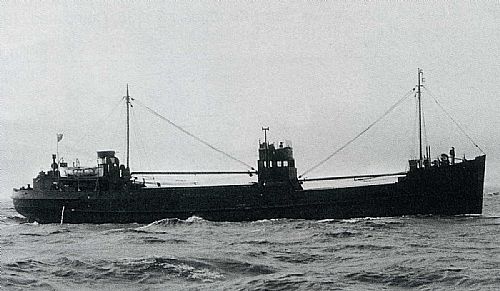
Captain Kompothekras-Kotsoros however tells a different story. The Panayiotis was traveling from Greece to Albania with a legitimate cargo and ran into mechanical problems on the night she ran aground. Unable to maintain steerage in poor visibility on a stormy night the crew ran her aground on the sandy beach which has assumed the name Navagio (shipwreck in Greek). The cove has been named Smugglers Cove in honour of the rumours surrounding the shipwreck and attracts many thousands of tourists every year who travel to admire the rusting remains high above the tide line. She lies with her back broken and part of one side missing and will soon be in two halves as the elements gradually reclaim the beach.
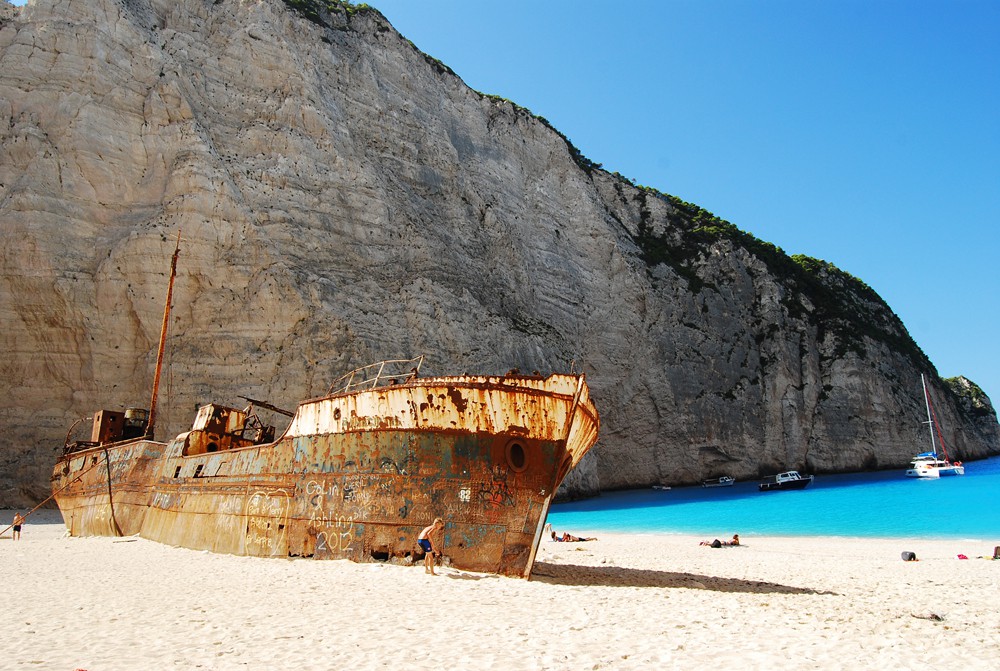
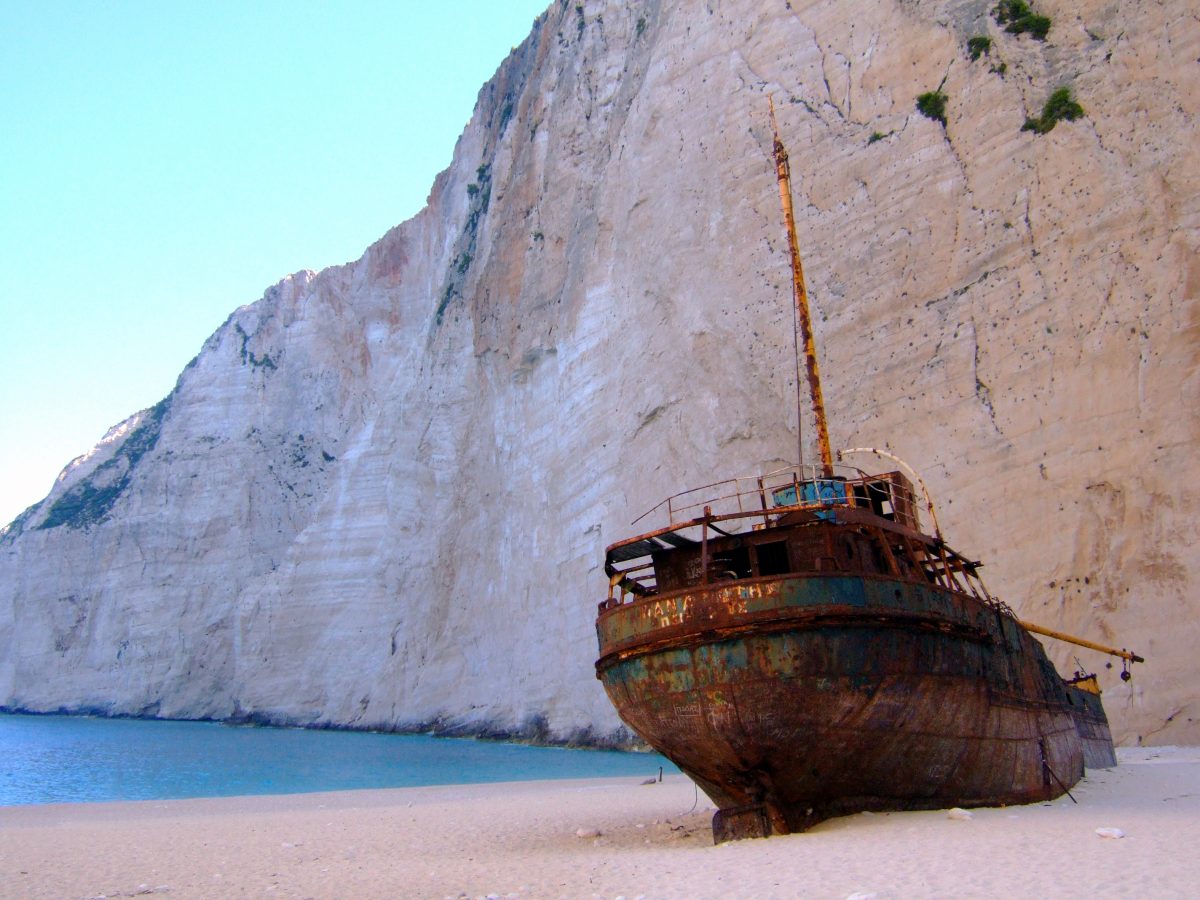
Although the tales of smuggling and contraband have been put to rest by Captain Kompothekras-Kotsoros there is an interesting twist to the story. After calling back to the shipwreck some time later Captain Kompothekras-Kotsoros found that some of the cargo and much of the removable equipment including navigation aids had been looted from the ship. He alerted the authorities and 29 arrests were made in the local community after police recovered much of what had been stolen from houses in the local village. The thieves were prosecuted and Captain Kompothekras-Kotsoros left only with the requirement by the authorities to remove the shipwreck.

After revisiting the wreck Captain Kompothekras-Kotsoros was struck by the beauty of the ship sitting aground on the white sands and he decided to leave it there. He has since retired to his birthplace of Kefalonia to run a villa and apartment complex.
SS American Star
Today I am going to talk about the SS America an ocean liner and troop carrier which operated from the 1940’s until the early 1990’s before meeting its fate on a sandbar in the Canary Islands.

The SS America was built in the late 1930’s designed to be a top of the line cruise ship able to carry 1200 passengers in luxury across the Atlantic Ocean. It weighed in at 26,000 tonnes and featured 10 passenger decks containing first class, second class and third class cabins. The SS America launched on the 5th of August 1940 as a cruise ship but was quickly converted into a troop carrier for the United States Navy, which was fighting in World War 2 at the time. It was able to hold up to 9000 troops and was fitted with light weapons on the upper decks. The SS America made many crossings over the Atlantic during the war bringing troops over to Europe and back to the United States.

After the war finished the SS America was then refitted with all of its luxury amenities and was redeployed as a passenger cruise ship, continuing to make voyages over the Atlantic. Many United States passengers took a lot of pride in being on the ship due to its service for the country during the war. Passengers also took pride in traveling on the ship as it was the top of the line cruise ship for the American cruise industry at the time.


The SS America continued to operate throughout the 1950’s and 1960’s until it was sold by the United States SS line in 1964. The decision to sell was made because cruise ships were falling out of favor with the public as a means of traveling over the Atlantic. Air travel had become a cheaper and faster alternative.

The SS America was bought by a Greek cruise ship line called the Chandris Line where it was named the SS Australis. It was then repainted white to match the Chandris Line’s brand colours and began making hundreds trips from Europe to Australia and New Zealand over fourteen years. It was then sold in 1978 to an American shipping company called Ocean Venture Cruise Lines. Under its new ownership the SS Australis was then renamed the SS America for the second time and repainted to its original colours. It then began making cruises from New York down to the Caribbean Islands. This only lasted for two months before Ocean Venture Cruise Lines went bankrupt and the SS America was seized by creditors and resold to the Chandris Line.

In Ocean Venture Cruise Lines two month ownership period they seriously neglected the ship, failing to carry out any maintenance on it and basically just let it deteriorate. The Chandris Line then named the SS America the Italis and ended up dry docking it due to its poor condition and outdated design.

Chandris Lines then sold it to Noga a shipping company who planned on using it as a prison ship. The plans to do this however fell through and the ship remaining docked in a bay in Greece for many years to come. As more and more time passed and the condition of the ship deteriorated the more it appeared as if it was going to have to be scrapped.

The ship was then sold again to another shipping company who called it the Alfredos and continued to let the ship deteriorate. The boards on the upper decks were rotting away and the hull was starting to rust. One day a bilge pipe burst in the ship’s hull causing water to burst inside and start to tip the ship over. The ship was however saved with the water quickly being pumped out of the hull. It was then sold to a scrapping company who began dissembling it.

Another shipping company based in Thailand then decided to buy the ship while it was in the process of being scrapped. This new company changed its name to the SS American Star and planned to use it as a five star floating hotel in the city of Puket.

After 14 years of not being used the SS American Star began its journey from Greece to Thailand. This journey was meant to take over 100 days to complete. This is because the ship had to be towed by tug boats around Africa. The first few days of the tow went well but then on the 17th of January 1994 things made a turn for the worse. The tug boat and ship entered into a massive violet storm resulting in the tow rope snapping in the middle of the night. The crew on the tug boat then boarded the SS American Star to attempt to reattach the line however these attempts failed. Many more tug boats came to assist in the rescue but where unsuccessful in there attempts to help as the weather was just to violet.


The crew where then rescued off the SS American Star by helicopter leaving the ship to drift away. The ship continued to drift until it washed up on a sandbar off a beach on the island of Fuerteventura. The ship did not appear to have any hull damage after being inspected so the new owners took there time to figure out what there next move was. In the time that they spent thinking about what to do next the waves continued to violently pound against the side of the ship until the ship couldn’t take it any longer and split in half.


The insurance company deemed the SS American Star as a complete loss and the new owners decided to just leave it abandoned there. Over the next few year the people on the island of Fuerteventura began looting everything of value of the ship even creating a zip line between the shore on the beach and the ship. Many people attempted to swim from the beach shore to the ship as well which resulting in quite a few deaths by drowning.

Eventually in the mid 1990’s the stern of the ship collapsed underwater leaving only the bow half of the ship left standing. Then in 2005 the bow of the ship collapsed over to one side. From 2005 to 2014 the ship slowly began to submerge itself under the waves leaving nothing to be seen by 2020.



I found researching and writing about this ship really interesting due to its history as a navy ship during the war before serving its purpose as a cruise ship, even voyaging to New Zealand at one point in its life. I found it interesting to learn about its demise with it being dry docked for all those years and seeing it pass through all of the different owners who didn’t end up doing anything with it. It was also interesting to learn about its redemption from the scrap yard under new ambitious owners which resulted in its tragic final journey. I was also captivated by the photos of the wreck showcasing its slow demise over the years. Part of me wishes that it hadn’t completely submerged under the waves as it is such and interesting monument to look at as a shipwreck.

I hope you enjoyed this post. This blog is for the people who are interested and passionate about shipwrecks and the stories they have to tell us. If you are keen to learn about other shipwrecks please checkout my other postings.
MS World Discoverer
The MS World Discoverer is a cruise ship that stuck a reef in the Solomon Islands in the early 2000’s and has been lying there abandoned ever since.
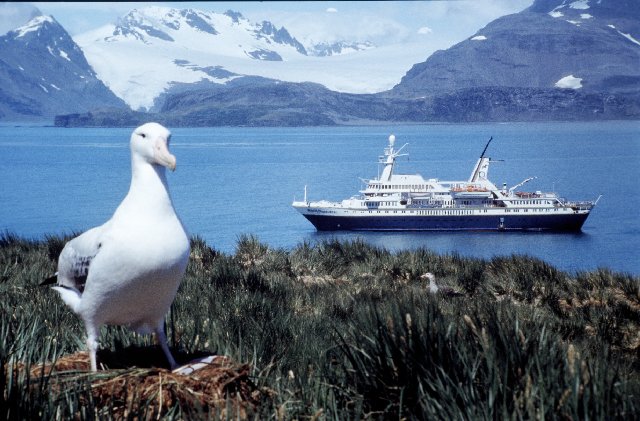
The MS World Discoverer was built in 1974 in a German shipyard. The ship passed through the ownership of a few cruise line companies and before being bought in 1987 by Society Expeditions. Society Expeditions registered the World Discoverer is Bolivia in order to take advantage of the lower employment standards.

The World Discoverer got its hull upgraded under Society Expeditions ownership so that it could withstand small iceberg impacts and cruise around the arctic seas. It also underwent a fairly major refurbishment in 1993 to make the sailing experience more luxurious for the 170 passengers and 80 crew members.

The World Discoverer wasn’t a large cruise ship weighing only 3700 tonnes when compared to the Costa Concordia which weighed 114,000 tonnes. The smaller size of the ship meant that it wasn’t built for doing large cruises and mainly catered to the market for smaller cruises. This meant it didn’t have many amenities for the passengers, with the standout features being a lounge, library, pool and observation deck. The small size of the ship and lack of amenities meant that it mainly focused on getting passengers to their destination instead of the journey there.
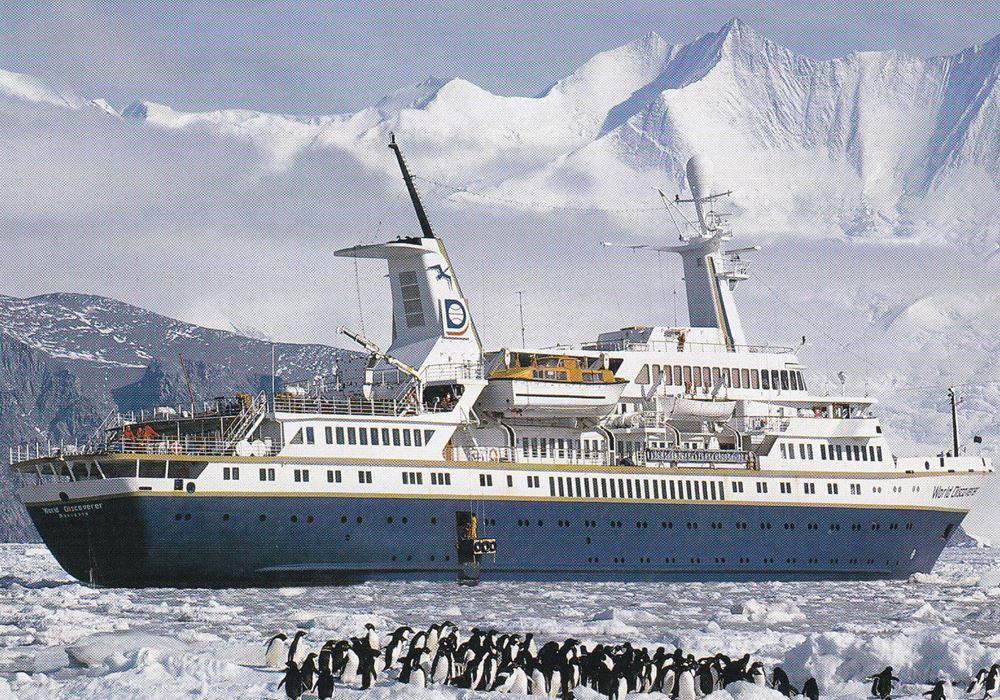
The World Discoverer went on expeditions around Antarctica and Alaska and Chile before its fateful cruise through the Solomon Islands.




On its last cruise the world discover was meant to pass though a passage in the Solomon Islands known as the Sand fly Passage. On its way through the passage it stuck and uncharted reef or rock. Immediately after the impact the captain sent out distress calls as he knew that the strengthened hull wasn’t enough to stop the rock from piercing through.


After the distress call was received a ferry was dispatched to the World Discoverers location. The captain of the World Discoverer knew that he could not keep the ship afloat at its current position as the ship had stuck the reef halfway across the passage. The captain decided to steer the ship into a small bay called Rodrick Bay in order to prevent it from completely sinking.


Once the ship had made it into the bay all the passengers and crew evacuated the ship safely. The ship then began to tip over taking on more and more water before eventually tipping onto its side. The speed at which the ship tipped over meant that there wasn’t enough time to do any emergency repairs. This therefore meant it was a complete write off. Although it was deemed to be a complete write off there were a few attempts to salvage it which all failed.

Unlike the last few shipwrecks that I have talked about on this blog (Costa Concordia and MTS Oceanos) nobody was really at fault. This is because the ship was travelling through relatively unknown waters at the time. Unlike the other shipwrecks I have talked about the captain and crew were praised for their efforts in evacuating all of the passengers off the ship safety and professionally.








The question of what will happen to the World Discoverer is still uncertain. The locals living on the Island scrapped the ship of all of its valuable parts including all the interior, equipment and windows rendering it basically worthless. With the previous efforts to remove it failing it appears that it will remain abandoned.
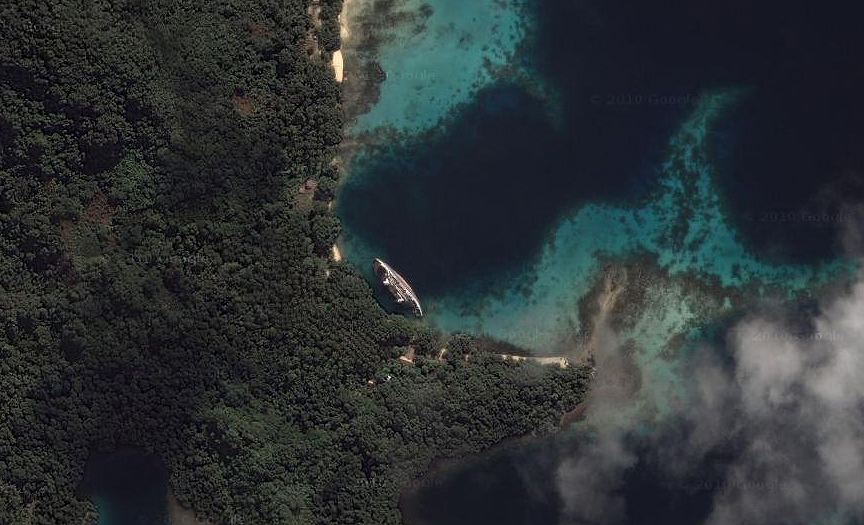
Since the World Discoverer is lying in a bay it is less effected by the shore line waves meaning that it is likely to remain there for roughly another seventy years. Because nobody actually technically owns the World Discoverer after Society Expeditions went bankrupt it is up to the government to remove it and it is not looking likely that that will happen even after the locals begging for it to happen. Overall I found this shipwreck very interesting to learn about mainly because of how captivating the photos are to look at.
MTS Oceanos
On August the 3rd 1991 a cruise ship named the MTS Oceanos began taking on water off the coast of South Africa with more than 500 people on board. In this blog post I will tell the story of one of the greatest maritime rescues of all time.
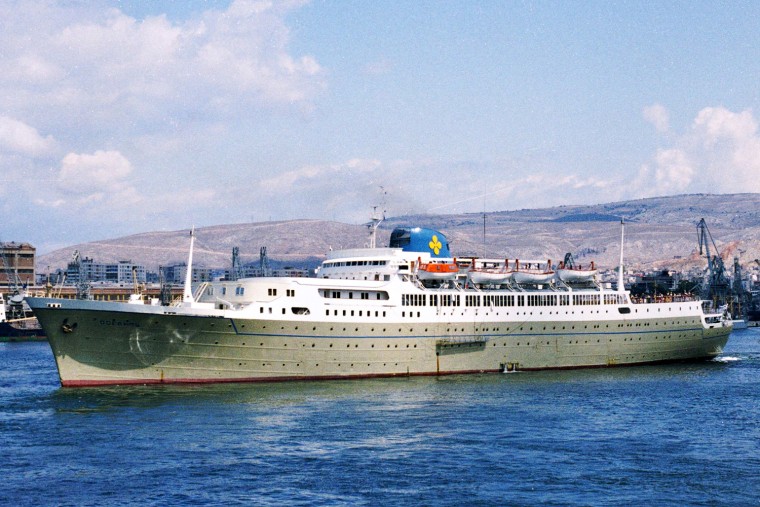
The Oceanos was built in 1952 in France and went through many different name changes and owners before being acquired by the Epirotiki Lines which was a Greek shipping company in the 1970’s and called it the Oceanos. Epirotiki Lines bought the Oceanos to take advantage of the emerging cruise line industry at the time. The Oceanos was basically just an old passenger vessel that had been refitted to have the amenities of a cruise liner. This was the normal back in the 1970’s for cruise ships as the industry was very different back then to what is like nowadays.

So in the late 1980’s and 1990’s the Oceanos began making regular cruises out from the port of South Africa. It was able to hold a maximum of 550 passengers and 250 crew members. It weighed around 14,000 tonnes so not a lot compared to modern cruise liners like the Costa Concordia which weighed around 114,000 tonnes. The Oceanos had a large open deck swimming pool, multiple dining rooms and an onboard casino.

Before the disaster the Oceanos was being leased by TFC Tours of Epirotiki Lines to take advantage of the untapped South African market. The reason why this market was untapped by cruise lines was because of the extremely rough waters. The Oceanos left from Cape Town to Durban stopping off at Port Elizabeth and East London on the way there and on the way back. The ship was captained by a man called Yiannis Avranas.

Before leaving on the cruise some of the passengers described the condition of the ship as looking neglected and rusty.

The Oceanos however was still declared seaworthy and set sail from Cape Town to Durval stopping off in Port Elizabeth and East London on the way. On the return trip from Durval to Cape Town the Oceanos stopped off in East London to take on more passengers for a single night cruise. When the Oceanos was set to sail off that afternoon the wind picked up and the water began to swell. Captain Avranas was advised that the conditions out at sea were to rough but after delaying the departure for a few hours he decided to set sail anyways.

The Oceanos had to travel through the Transkei Coast Line which is known for its extreme sea conditions. The Oceanos left with 571 people on board with weather conditions getting worse. Below deck the Oceanos began to run into some problems. Earlier that day maintenance had been done to the ships water disposal system with the pipe that intakes sea water into the ship not having its non return valve fully replaced. It has been speculated that the waves slamming into the ship burst the shell plate on the pipe off spilling sea water into the ships engine room. This then resulted in the ship losing power.
After the power cut captain Avranas checked out the damage and reportedly enetred into a state of shock as he returned to the ships control room. The crew began to send out distress calls. As all of this was going on the passengers waited in the dining room with the ships entertainers playing songs and interacting with them. The passengers had been told that everything was ok and it was just an engine malfunction but they should start preparing to abandon the ship.

With the Oceanos slowly starting tilt over to one side the crew were seen lowering lifeboats. They were also seen throwing their suitcases into the lifeboats before entering them and abandoning the ship. The Oceanos had a lifeboat capacity for 594 passengers meaning there was enough space to save everyone. The first life boats however had very few actual passengers on them and were mainly filled with crew members and their belongings.

Some of the entertainers decided to go below deck to see what was going on with the engine and found water pouring into the ship and sloshing around from side to side. Up until this point no alarm had been sounded and the passengers had no idea what was really going on.


Because the crew had already abandoned the ship the entertainment staff took charge of the rescue and started ordering people into lifeboats and making distress calls back to land.

It then got to the point where the ship was tipping to far over to one side that it made launching lifeboats impossible. At this time there where still 220 people on board due to the crew members all leaving in half empty lifeboats. Meanwhile the captain was doing nothing to help and was earlier seen attempting to board a lifeboat but caught and turned away by the ships entertainment staff.


Luckily some nearby ships got the distress call as well as the South African Air Force, which sent out a helicopter rescue. The two helicopters deployed on the rescue took 20 passengers at a time the three mile journey back to shore. They then refueled and headed back to the Oceanos to rescue more passengers until all 571 passengers were off the ship.
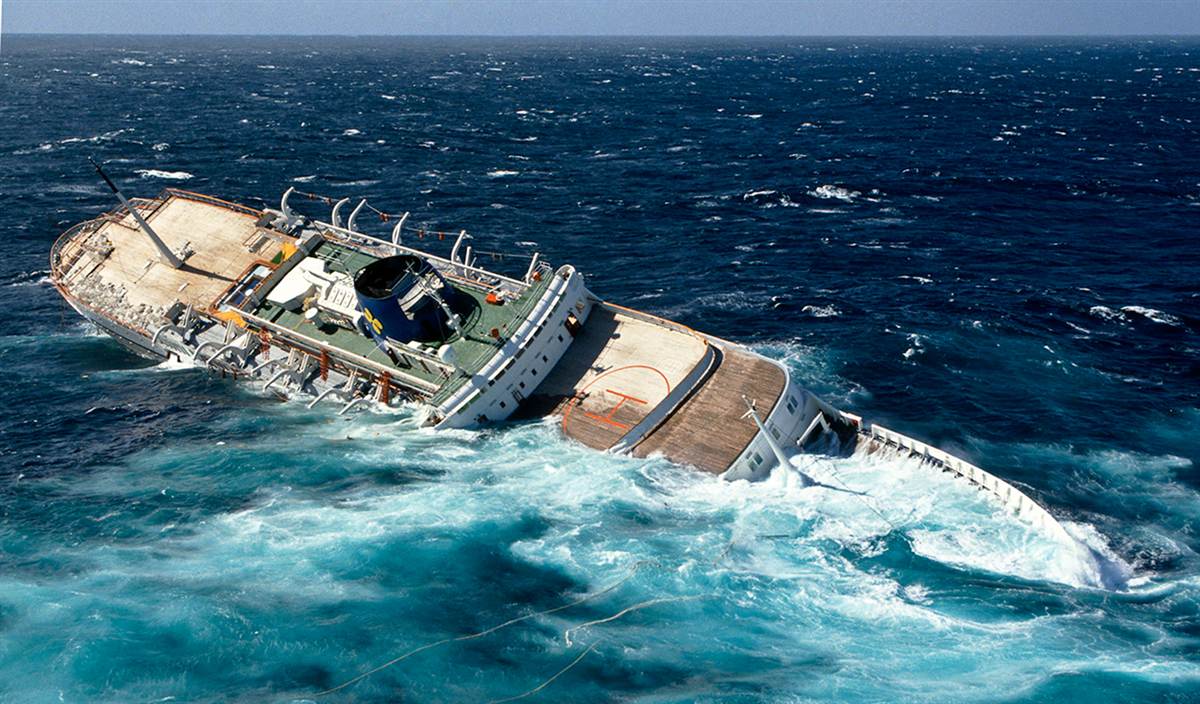
The last moments of the Oceanos were captured by ariel photography as the ship finally went under not long after everyone was successfully rescued.
The aftermath of the disaster resulted in the entertainment staff being regarded as heroes. As for Captain Arvana he was one of the first people airlifted off the Oceanos and has been criticized heavily in the way that he handled the whole situation.

Overall I think that the passengers of the Oceanos were very luckily to survive. If the leak had been worse the rate water would have entered into the ship would have been faster. This would mean the chances of everyone making it of the ship in the middle of the night in a harsh storm would be very slim. It was also crazy seeing the Ariel footage of the Oceanos go under as well as learning about the rescue mission by the ships entertainers and South African Air Force. As for the wreck of the Oceanos it is lying on the seabed but strong currents in the area make it hard to explore.
Costa Concordia
The Costa Concordia was a cruise ship that wrecked off the coast of Italy on January the 13th 2012 killing thirty two people. So what happened on that tragic day?

To give some background on the Costa Concordia. It was owned by the Carnival Corporation and was the largest ship in their fleet when it entered service on the 30th of June 2006. The Concordia was 290 meters long and cost 570 million US Dollars to build.

The Concordia was the top cruise ship in the world at the time it was built. It had five restaurants, 13 bars, 1502 guest cabins and 601 crew cabins meaning it could accommodate 4890 people on board. Some of the standout features of the Concordia that made it a Flagship ship were the grand atrium that spanned over ten storeys high and the two story spa with four pools and a giant twisting water slide on the top deck.

Since the Concordia’s launch it was captained by an Italian man named Francesco Schettino. The Concordia spent most of its life sailing around the Mediterranean sea up until the fateful day of January the 13th 2012.

The Costa Concordia left on a 7 day cruise on January the 11th 2012 two days before the disaster occurred. After two days of sailing around the Mediterranean sea and a stop in Sicily the Concordia arrived in Civita Vecchia Italy. The Cruise ship then set sail at sunset on its way to Savona.

The official route that the Concordia was to sail took it between Italy’s mainland and the island of Giglio. The Concordia was meant to sail directly down the center but instead it deviated from the official route to take it much closer to Giglio Island. This was done to give the passengers a better view of the island. The Concordia had made this deviation several times in the past without any issues.
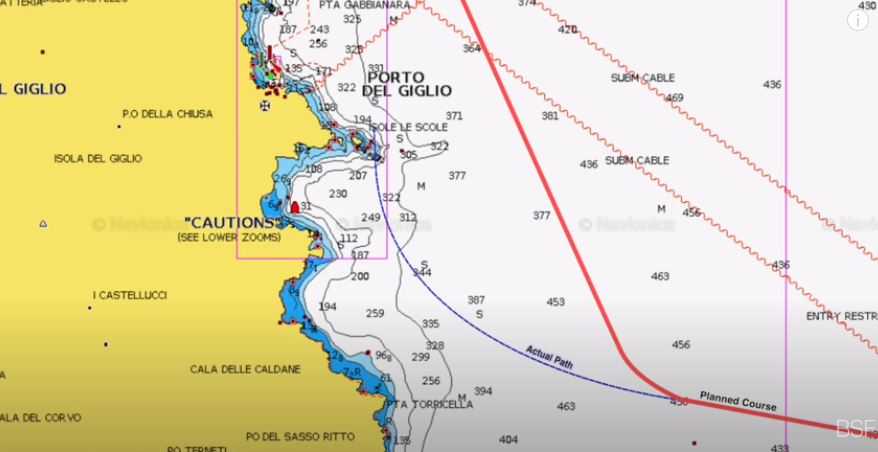
As the Concordia is making this deviation towards the island, deck officers are guiding the ship as Captain Schettino is eating dinner. The officers are told to keep at least 450 meters off the islands shore as that was the determined safe distance. At 9:40PM the Concordia is moving towards the island shore at 28KMPH and is about to make its turn to pull up along side the islands shore. Captain Schettino then returns to the bridge where the deck officers are and instructs the officer in charge of steering the ship to begin making the turn.

However there is a miscommunication between Captain Schettino and the Officer over what the correct turning course should be. Because of this miscommunication the Concordia ends up making a much wider turn than it should have made. This error put the Concordia 659 meters closer than what it should have been. When Captain Schettino notices the error in the turning radius he quickly turns the ship 20 degrees to the right. Seconds later at 9:44 the Concordia strikes underwater rocks of the islands shore on its left side breaching three watertight compartments across 60 meters in the ships hull.
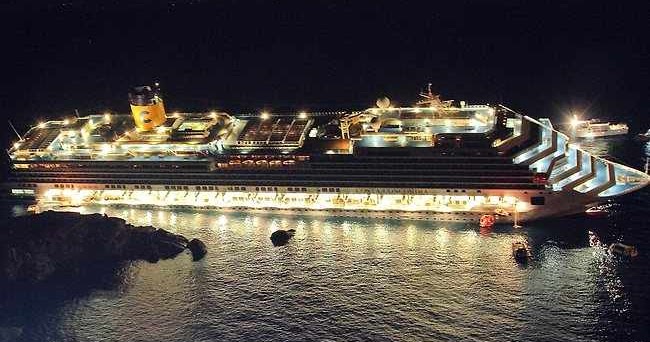
Upon the impact with the underwater rocks the Concordia loses all power from its generators and two engines. This was because the water breech destroyed the ships main electrical panel. The loss of power caused a blackout sending passengers onboard into a state of panic. Once the emergency generators kicked in the crew made a series of announcements to try to keep passengers calm, telling them that the situation was under control and that it was just an electrical failure.

As the water starts to fill up more of the watertight compartments in the hull the ship begins to tilt over to one side. The passengers and crew begin to make their own way to the lifeboats. At 10:35PM the crew calls for an abandon ship. By 11:30PM the ship is tilting so much over to on side that lifeboats can no longer be launched from one side. As the ship began to tip over people started making their way on top of the hull by a rope ladder. By this time Captain Schettino had already returned to shore and refused orders from coast guard to return to the ship to help the passengers.


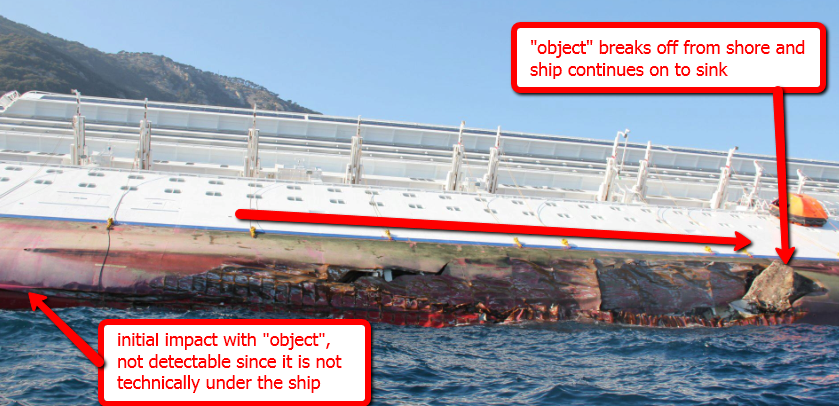
By 6:17 the next morning the rescue operation had finished. Because the ship lay submerged on one side it exposed the damage caused by the rocks. The salvage of the cruise ship began but proved to be quite difficult as the ship weighed over 114,000 tonnes and was laying half submerged on its side.
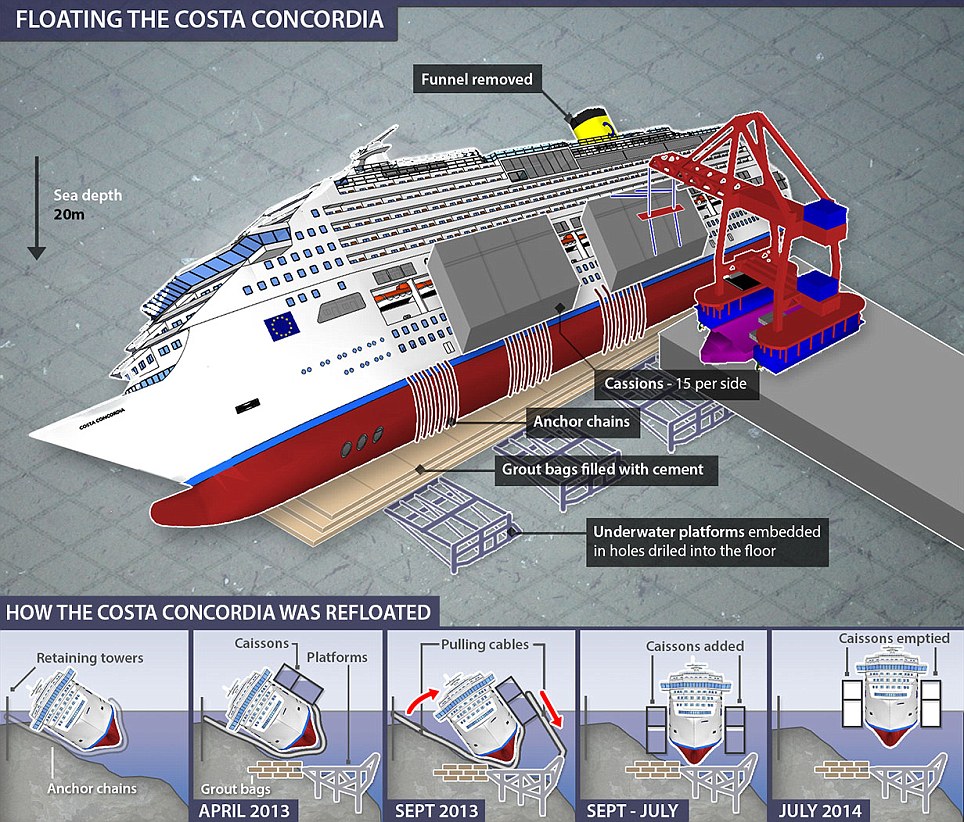

The salvage plan required a large steel structure to be placed underneath the ship and then turn it upright with massive buoyancy tanks being welded to the side of the gash caused by the rocks. Once the ship had been turned upright it exposed the full extent of the damage which meant it was a complete insurance write off for $500 million. More buoyancy tanks were then welded onto the other side of the ship and the wreck was then towed away to be scrapped in the port of Genoa in Italy. The ship was finally scrapped by July 2017 costing $1.2 billion.

The aftermath of the wreck resulted in 6 arrests for the ships officers with a few of them resulting in jail sentences for around two years. Captain Schettino was charged with manslaughter and sentenced to 16 years in jail. In the trial Schettino said that the only reason why he couldn’t help the passengers on board was because he accidentally slipped and stumbled into a lifeboat which then got launched to shore. Footage then got released of him casually boarding a lifeboat which he claimed was not him. The only good thing that Schettino did was to allow to Concordia to drift back to shore before submerging because if he hadn’t done that the ship would have sunk further offshore and most likely killing a lot more people.


The carnival corporation refunded each passenger $13,000 for the ordeal with the overall cost of the shipwreck estimated at $2 billion.
Welcome to my Blog!
It is estimated that there have been over 3 million shipwrecks during the course of history from 10,000 year old wrecks to modern day wrecks. It is believed that we have only explored just 1% of the wrecks out there.
In this blog I will be talking about a few of the most astonishing shipwrecks that have been discovered, Enjoy!





